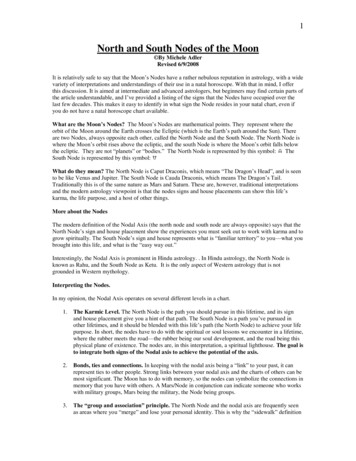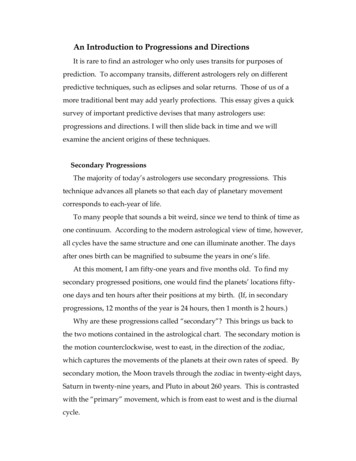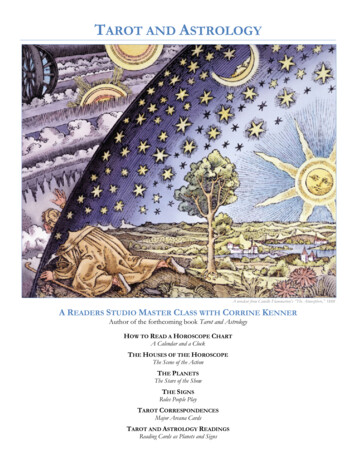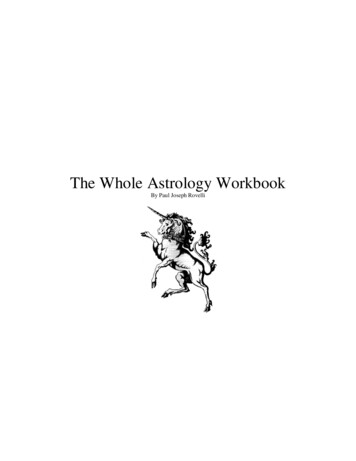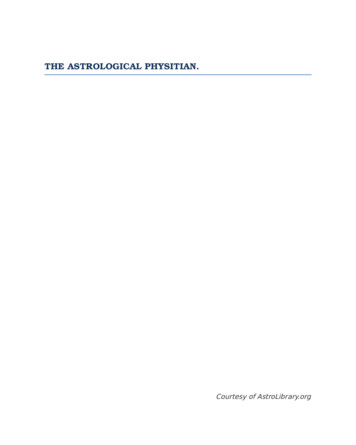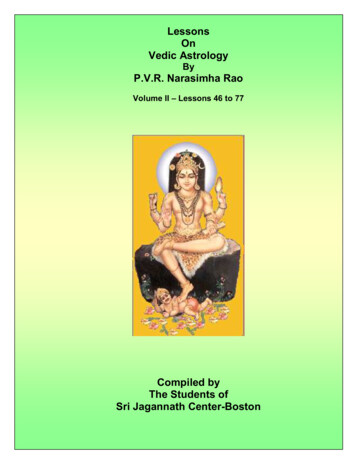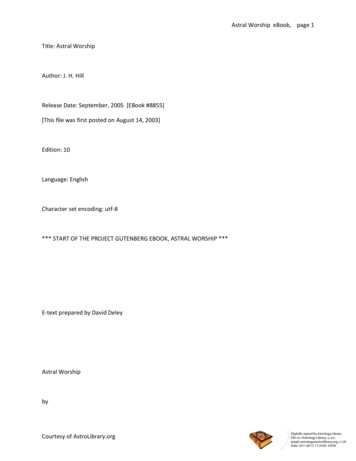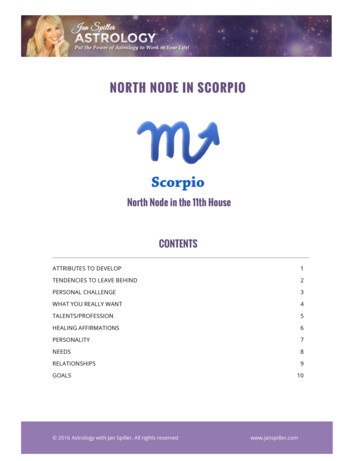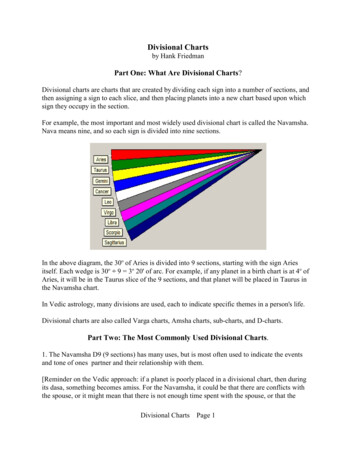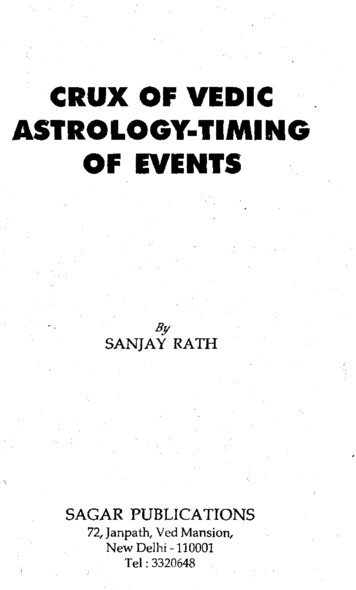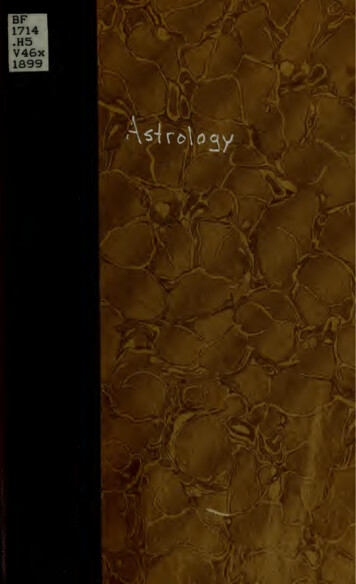
Transcription
?f .**i«;vv:aiw.'»vi mn )
THE IWMAgfBSIGHAM YOUNG Umvmiff
ASTROLOG Aisr»Ml?CONNECTION WITH VEDANTABtCVENKATABAO, buA Sheristadar flafyPARTofDistrict.IFiKoT DmON.(1000 Copii s)- ' (1bv D. V. Kkin:n\n/*BELLARY.1899.17 r;qfJs rrerrrrd.4
ASTROLOGYAnditsCONNECTION WITH VEDANTAByC VENKATA RAO,Acting Taluk Sheristadar ofRayadrug, Bellary District,PARTI(1000 Copies)Printed by D. V. Kristnan&Co.,IRama Vilasa Press,AT THE [BELLARY.;1899.All rights reserved.%U .'
BRIGHAM YOUNGUNIVERS/TV
EK/K/ 01410 1026Read.Fob.benificialbeneficial.12th January toJ 2th January2th April to12th annure.manure.
PREFACE.Numerous pamphletsHindn Astro-in English onlogy, having appeared of late, the pubUcation of this Editionseems to be a superfluity andcalls fora wordofexplanation.Almost all the works extant treating about Astrology are, more or less, verbatim translations of the original Sanskrit works.The student is asked simply to note-down the methods of calculation without any explanationsas to what the various figures in the calculations represent.Instances are not a few in which an Astrologer has beenable to prepare calendarsfor a series of years by merelyworking out the formulas without himself knowing themeaning of an intercalary month. One of the benificialadvance of education has been, as one ofthe eminent civilians presiding at a prize distribution inresults of thea college lately said, tomake meninquisitive in its bestEnglish students of Astrology often come in con-sense.tact withtechnical wordsand methodsof calculationwhen they take up the most elementary books onAstrology so much so that an elementary knowledge ofeventhe arrangement of the heavenly bodies and Astronomyisabsolutely essential.Yarious students of Yedanta have also found, that inthe study of the creation of the world and other mattersconnected with the Hindu ceremonies a knowledge ofAstrology and Astronomythis book,whichistochiefly, to give a briefcalitieswhich occurpositionsof theisform thenecessary.first ofThea series,isobjecttherefore,description of the variousin everyoftechni.work on Astrology, and theplanets etc, in as simple a language as
possible avoiding technical terms. In doing so the authordoes not aim at any display of scholarly knowledge ofeither Hindu Astrology or Astronomy. As a zealous stu-dent of the subject for some years having himselfperienced greatliasdifficulties inex-understanding the subject heventured to publish the following pages with a hope,may serve as a guide to others similarly circumwho may have a fancy for the subject and yet maythat theystanced,have given upitsstudy for want of suitable books whichexplain the technicalities.I fearImay becriticisedasbeing unduly callous in attempting at publication, withbut a smattering knowledge in the language as well asthe subject but I close my preface with the followingwords of CardinalNewmanwhi(3h I hope will fullymeetthe public criticism."inWholesome ascommon withallpublic opinionisas a principle,ithasthings human, great imperfections andmakes many mistakes".amcharged with being shallow on the one partif I myself feel that fastidiousI shall console myself withness at my own attempts,enough to do more thanlongnotlifeisthatthe reflectionIf Ior off-hand on the other,our best, whatever thatmake notaking aimnever gain;mayhits;be:that theythat to be ever safethat to do some substantial goodmuchthat theyisiswhoare everwho never ventureto be ever feeble;andthe compensation foraccidental perfection.The appearanceof thisbook has been rendered prac-ticable only through the help of M. R. Ry. VijianagatamKristnahimRow Garu of Bellaryand the author cannot thanktoo much.The Author.
Astrology and its ConnectionWITH Vedanta.CHAPTERI.Astrology and Astronomy formed a favourite studyHindus in ancient days. A knowledge of tlie subPara Brahmam.ject was found essential to understand theof the VedauxiliariesorIt forms one of the six angamsantic literature, and in fact without a knowledge ofof tteAstrology some portion of the Vedas, especially theMantras, may not be correctly understood. According tothe]Dharmasastras every individual has to enter into 16stages ofcommencing fromlifehis birth,knowngeneral-Shodasa Karma" ( e : ) the most important of which are the Thread-marriage ortheUpanayanam and Marriage. Every Vedic Mantra relating to theseKarmas, nay, even the daily ablutions of the Brahmanly as the "knownSandhya has a reference to the constellation of stars, the Lunar and Solar motions, the planets,and also to deities ruling the five elements. A knowledgeas theof thesetherefore necessary toiscorrectlyknowtheMantrams and it is to attain this knowledge the Hindus have recourse to the Jyothisha Sastraand not for purposes of lucre, nor for purposes of curiosity meanings of2.the,The Vedanta contemplates threeclassesAtmas knownofgenerally as Adhikariesnoted in the margin. Under the first class.2. Madnyama. -,4,i-trtearncbLcome the Yogis who are always3. Adhama,devotion towards Para Brahmam and whohave no regard for the earthly transient seeming happi1.as-ynttama. im
The secondtiess.class consistspersons ofofmuckdevotion but sailing in the ocean of Samsara or worldlycares combating to seek after the true knowledge or Ta-Under thetwa.thirdclasscomeThecovet only the earthly happiness.whothe personsallfirst class of soulsabove the stage of Karma, that is to say, their devotion is so staunch that their minds cannot be divertedto any other things ; anything they do will be pure andisvirtuous andThelastalways turn to an advantageous account.class of persons may be styled as outlaws, andany numberof penal clauses will not swervetheir path.Theyaredoomedto bethem fromIt isincorrigible.therefore only to the middle class of persons with an un-steady mind, butstillopen to conviction, that the Srutisand Smritis prescribed theAstrology has a close bearing onsin.andreligious rites as expiation ofKarma Vedantaalso contemplates the three sets of Adhikariesaboveenumerated.To theevery second in the Eternity is sacred and auspicious and coeval with the ever existing Sup3.reme Being andfirstas such they need not grope for auspiciousor inauspicious hours. Their mottodavya a great Rishi and YogiAstrologyistherefore that ofMan-*'s 23cs6o«So5 o2 ;5 o" 6- no use to them. It islikewise useless to the materialists coming under the lastclass. The middle class of persons to whose relief Karmaic: o."isthereforeofMantras exist has therefore to be guided by Astrology*Without knowing this distinction many in the presentdaysfall into error.This book does not purpose to dealwith religious questions but simplystudents of the subject believeditsets forthin ancienthowthedays and as
3such the arguments of the materialists as to the truthfulness of Hindu Astrology will not be discussed herein.Howand on what points a study of Astrologywould help the study of Vedas will be noted in dealingwith the subjects separately. The Hindu Astrology dealswith four distinct subjects, and the object of this littlebook is to present to the reader an outline of the systemin which those subjects are treated.4.Theyare:1.Astrological calculations or Astronomy (Sidhanta)2.Jataka or Horoscope.3.The Muhoortam or auspicious hours.The Prasna or Predictions on questions.4.5.Thefirstsubject has been sufficiently dealt withby the English Astronomical treatises and it seems unnecessary to dwell on it more than what is actually required for the study of the remaining three branches.It is only the remainingother subjects that have beenallowed to remain in darkness and they will be dealt within the following chapters in order. :o:-
CHAPTER II.:0:work— Everydeals with three subjects generally — subjects which formEssentials of Astrology:scientificThus a Geometricianthe basis for the whole structure.divides his subject into a Point, a Line, and a Superficies ;a Logician into Terms, Propositions, and Syllogisms aChemist into Solids, Liquids, and Gases or into Acids,Alkalies and Salts. The same is the case with reference to;Astrology.The prime factors are (1) The Time. (2) TheThe Planets. Esoterically these three factorsSpace (3jmay be taken to represent three Elements of creation,- viz,the Soul, the Prakriti and the Karma, the Space representing the Prakriti, Time the Karma and the Planets theSoul.2.Thefixed timeisrotation of the planets through space in theirthe cause of the various phenomena in thisThe movementsworld.ature proof as tohowof the planets afford but a mini-the Almighty Creator regulates histask of creation of this world,The3.kritiAll- wise Creator creates aaccording to the souFsinto the body.AsKarma andbody from Prathrusts that soulthese bodies are of different disposi-must be presumed that they are quite distinct fromand not his manifestations, for then, thattheory would detract the Almighty to the position of aSince this book is not intended to discuss relimortal.tionsittheir Creatorgions,it is sufficientto simply note that in arguing similarpoints in connection with Philosophy, the relation between Vedanta and Astrology can be stretched to anyextent, and that a knowledge of Astrology will be useful.
Time and4.its Sub-divisions-Necessity for—Time as is well-known is always fleetsub-divisioning and eternal, and to identify a particular portion oftime is therefore a very difficult task.:The5.several nations of the world have thereforebeen in the habit of calculating time with reference to aparticular event of importance, such as the birth of afamous king or a prophet or a conquest and thus havesprung up the Christian Era, the Hijira, the Vikramarkaand Salivahana Eras and the Kollum Andu.In Hindu Astrology similarly the creation of6.Brahmaissions arethe beginning of calculations andnamed withsub-divi-reference to the subsequent epochs.Various sub-divisionsmayGeneral (2) The Specific.two is very important andTheTheitsbe classed into(1)Thebetween themay be known from the followdistinctioning examples.7.Hindueral sub-divisionssub-divisions ofTime :— The Gen-are a Kalpa, a Manvantra, a Yuga, anEra or a Sakha, a Century, i. e. a Generation, a Year, aSeason or Ruthu, a Month, a Fortnight, a Week, a Day,an Hour, a Ghatika and a Vighatika. These are generalterms. Standards vary, i. e. the periods covered by themare not uniform e. g. the number of years comprised in aSwayambhuva Manvantra need not be the same as that inthe Yyvasvatha, nor is the number of years in a Kali Yugathe same as that in the remaining three Yugas. The difference is the same as that observed in specified Englishmonths such as January, February &c while a month isgenerally 30 days.
Definitions of some periods:8.The following definitions:—of sub-division of time willhe found to be useful. A Kalpa represents the lifetime ofBrahma. Manvantra shows the lifetime of a Manu. ThereThe period;are 14 Manvantras in one Brahma Kalpa.isA Yuganot uniform.butlessisa large sub-division ofthan a Manvantra andistimenamed accordingtoand decline of Vedantic knowledge. Thus in KritaYuga Vedantic knowledge was in its ascendancy, in Thraitha Yuga J less, in Dwapara Yuga less, and in KaliYuga f of the Vedantic splendour is devoured by theThese Yugams may be taken tovarious other religions.risecorrespond with the ancient classifications of the Golden,the Silver and the Iron age.A9.yearisgenerally the time occupiedrotation of a planet round the Earth.by theThere are as manydifferent years as there are planets, and the period variesaccording to their distance from the Earth. Thus a Lunaryear measures only 354 days, while a Solar year has365 days.The yearofMarsis stilllonger.Soalso isthat of Jupiter and Saturn in order.10.Hindu years generally in vogue :— Butthough there are diferent years for each planet accordingto its distance from the earth Hindus generally divided theyears into only five classes for purposes of their religiousThey are (1) The Chandramana, (2) The Sowramana (3) The Savana, (4) The Nakshatramana (5J Therites.Barhaspathyamana.11.The Chandramana runs from the Pratipada orday of the bright fortnight of Chaitra month tothefirsttheNew Moon dayofPhalguna measuringin all only354
the months represent will be explained inFor the present it may be menthe subsequent pages.tioned that the year derived its name from the motion ofthe Moon, for, the New Moon days and other Thithies, asWhatdays.will be explained later on,dependsolelyon the motionsMoon.of theor the Solar year runs from the firstday of the Sun's entering Mesham or Aries to the day ofhis leaving Meenam or Piesces. It consists generally fromThe SowramanaJftft« 12th January to 12thThe oavanarepresents any period of 360 days.itsname from the con-A rotationof the[constellation 12The Nakshatrika year gotstellation of the stars,timesisa Nakshatrika year.tions this yearAamountsThe periodstyled a Barhaspathya year.are 27 constella324 days.thereBarhaspathya year derivesmotion of the Jupiter.isAsto 12 x 27 oritsname from theof hisstay in a Rasiextends toIt generally361 days.12.byIn India the solar year is the one thatall classesyearisisadoptedfor purposes of calculation, while the lunarrecognised for purposes of ceremonies;the remain-ing are taken into consideration by certain classes inTheNorthern India only.time of the various yearsmindisdifferencein the length ofan important pointto beborneThe Devafrom any of the years above statedbecause the planets have no control over the Devas. ADevamana year amounts to several ordinary solar years inmanaisAinstudying the subject of creation.differentBrahmakalpaisan indefinitelylon-g period.
8The minor13.sub-divisions of a year viz. a season,a month, a fortnight, a week, a day, an hour, a ghatikaand a vighatika, also vary in their length of time in thesame prop
EssentialsofAstrology:—Everyscientificwork dealswiththreesubjectsgenerally— subjectswhichform thebasisforthewholestructure.ThusaGeometrician divideshissubjectintoaPoint,aLine,andaSuperficies; aLogicianintoTerms,Propositions,andSyllogisms;a ChemistintoSolids,Liquids,andGasesorintoAcids, AlkaliesandSalts.Thesameisthecasewithreferenceto Astrology.
